Curious about how bees survive winter? Discover the intriguing dance of adaptation and resilience these vital insects perform!

Bees Hibernate or Migrate?
Have you ever wondered where bees go during the winter? If you've ever had the experience of finding a bee in your home during the colder months, you might have assumed that bees hibernate, much like bears. However, the truth is a bit more complex.
Bees don't exactly hibernate, nor do they migrate in the traditional sense. So, what do they do? Well, it's a fascinating dance of survival that demonstrates the resilience and adaptability of these vital insects.
Curious to find out more? Let's explore this intricate world together.
Key Takeaways
- Bees don't hibernate in the traditional sense, but they enter a hibernation-like state during winter.
- Bees use thermoregulation to stay warm by clustering together and producing heat.
- Some bee species, like the African honeybee, migrate in response to changes in weather and flowering patterns.
- The survival of the queen bee is crucial for the survival of the entire colony during winter.
Understanding Bee Behavior
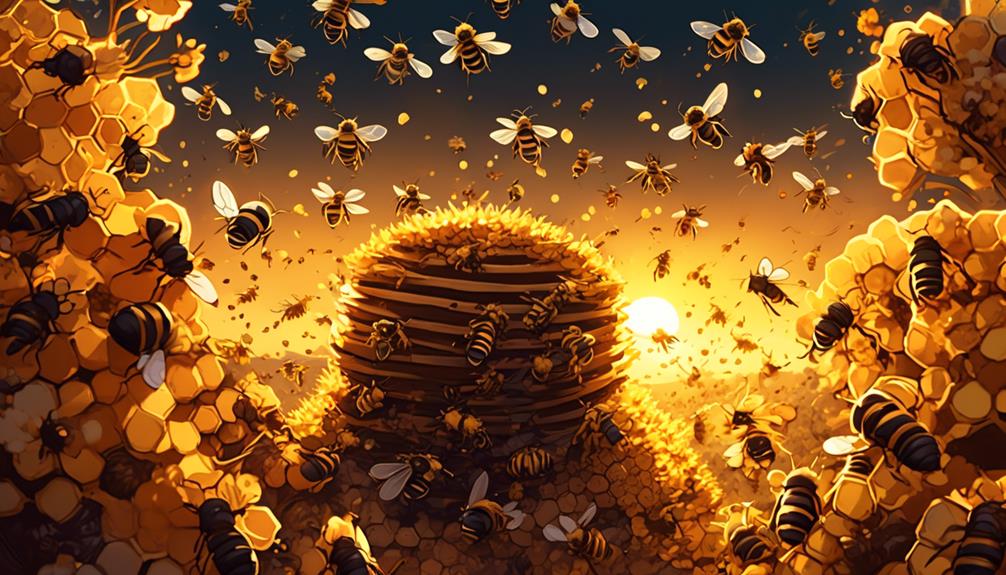
To truly grasp the fascinating intricacies of bee behavior, you'll need to delve into the scientific observations of their unique practices, such as hibernation and migration. These insects exhibit distinct habits based on external factors such as temperature, food availability, and season.
Firstly, let's talk about hibernation. Unlike many creatures, bees don't hibernate in the traditional sense. Rather, they cluster together in their hives, using their bodies' vibrations to produce heat and keep the queen warm during the cold months. This is a practice known as thermoregulation. It's a testament to their social structure and survival instincts.
Migration, on the other hand, is a practice commonly observed in certain bee species like the African honeybee, which often migrates due to changes in weather and flowering patterns. You'll observe that these bees don't just aimlessly fly around. They instead follow a well-structured path, guided by the sun's position and the Earth's magnetic field.
The Concept of Bee Hibernation
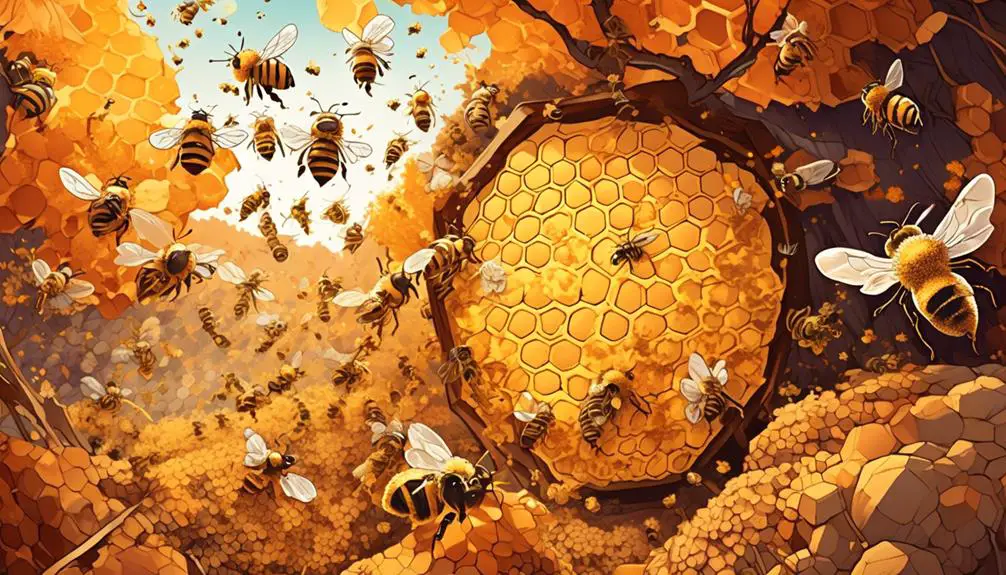
Shifting our focus from general bee behavior, let's dissect the concept of bee 'hibernation', a process that's as intriguing as it's crucial for their survival. Unlike mammals that truly hibernate, bees don't enter a state of deep sleep. Instead, they remain active within the hive, albeit at a much slower pace.
Honeybees, for instance, cluster together in the hive to generate heat and protect the queen. They shiver and twitch their flight muscles without flying, a process that generates enough heat to keep the colony warm. The outside bees insulate their comrades within, while the interior ones take turns moving to the periphery.
In contrast, solitary bees have a different hibernation-like state. After mating, the female solitary bee lays her eggs in the nest and then dies. The offspring remain in the nest in a dormant state, often as larvae, throughout the winter. Come spring, they metamorphose into adults to start the cycle anew.
Understanding this 'hibernation' process helps us appreciate how bees survive harsh winters. It's a testament to their adaptability, resilience, and a key reason they've thrived on Earth for millions of years.
Migration Patterns of Bees

In contrast to their 'hibernation' strategies, certain species of bees employ an entirely different tactic for surviving the winter – migration, a behavioral adaptation that's as fascinating as it's complex.
You see, not all bees are hibernators. Some, like the honey bee, don't migrate but rather hunker down and rely on stored food resources to get through the winter.
However, species such as the African killer bee, are known to migrate when temperatures drop. They travel in swarms, often covering hundreds of miles to reach warmer climates. It's a phenomenon that's as impressive as it's necessary for their survival.
While it's easy to view this migration as a simple move from point A to point B, it's much more intricate. Bees use a combination of solar navigation and memory of visual landmarks to travel. During the journey, they'll stop, create temporary hives, and continue once conditions are favorable.
The mystery of how they navigate such long distances remains a hot topic in scientific research. But, it's clear that this migration is a crucial survival strategy. It's a testament to the tenacity and adaptability of these remarkable insects.
Remarkably, bees' migration patterns continue to teach us about behavioral adaptability in the face of environmental challenges.
How Bees Survive the Winter
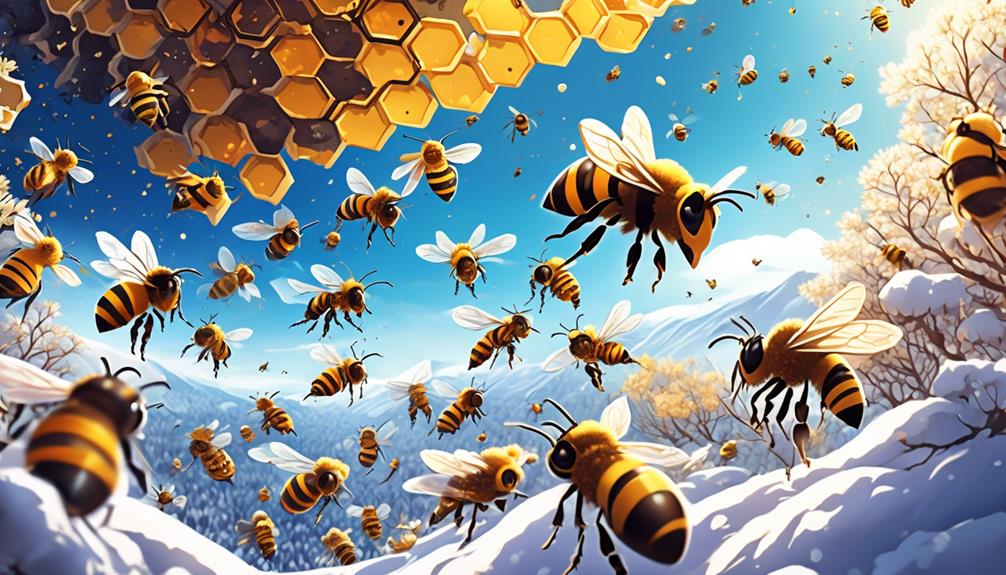
While bees' migration patterns offer a captivating glimpse into their adaptive strategies, understanding how these insects weather the harsh winter months unravels another layer of their remarkable survival mechanisms.
As temperatures drop, you'll observe bees implementing a survival technique known as 'clustering'. In essence, they form a tight group around the queen, conserving and generating heat. Workers shiver, creating warmth, while others feed on stored honey. When the cluster's outer bees chill, they're replaced by warmer ones from the center, ensuring the group's survival.
Yet, not all bees hibernate. The bumblebee queen, for instance, burrows underground alone. She emerges in the spring to begin a new colony, while her old one perishes.
In contrast, honeybees don't hibernate or migrate. Instead, they remain active within the hive, maintaining a steady temperature of about 93 degrees Fahrenheit, even when it's freezing outside. They achieve this through a remarkable phenomenon of 'thermal regulation', using their bodies to generate heat and consuming stored honey for energy.
The Role of Queen Bees in Winter
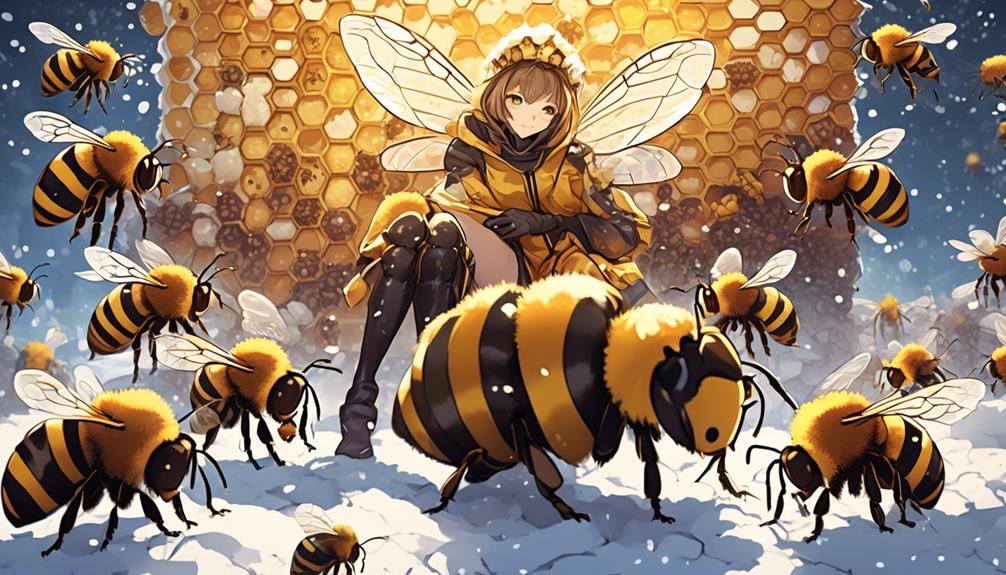
Diving into the depths of winter survival strategies, let's examine the pivotal role played by queen bees, who are the lifeblood of their colonies during these freezing months. As you may know, queen bees are the only females in the hive capable of reproduction, a role that doesn't stop when temperatures plummet. However, their responsibilities shift significantly.
In the winter, the queen's egg-laying decreases drastically, sometimes even ceasing entirely. This isn't due to the cold but is a result of the decrease in available food. With fewer mouths to feed, the colony's resources can stretch further. Interestingly, the queen doesn't hibernate or migrate. Instead, she remains active within the hive, surrounded by thousands of her dedicated worker bees. They cluster around her, generating heat through their collective muscle movements, keeping their queen warm and protected.
This cluster moves throughout the hive during winter, consuming stored honey and pollen to sustain themselves. Their singular goal is to ensure the queen's survival. If she dies, the colony dies with her. This intricate survival strategy is a testament to the queen's crucial role and the collective determination of the bee colony.
Human Impact on Bee Winter Survival
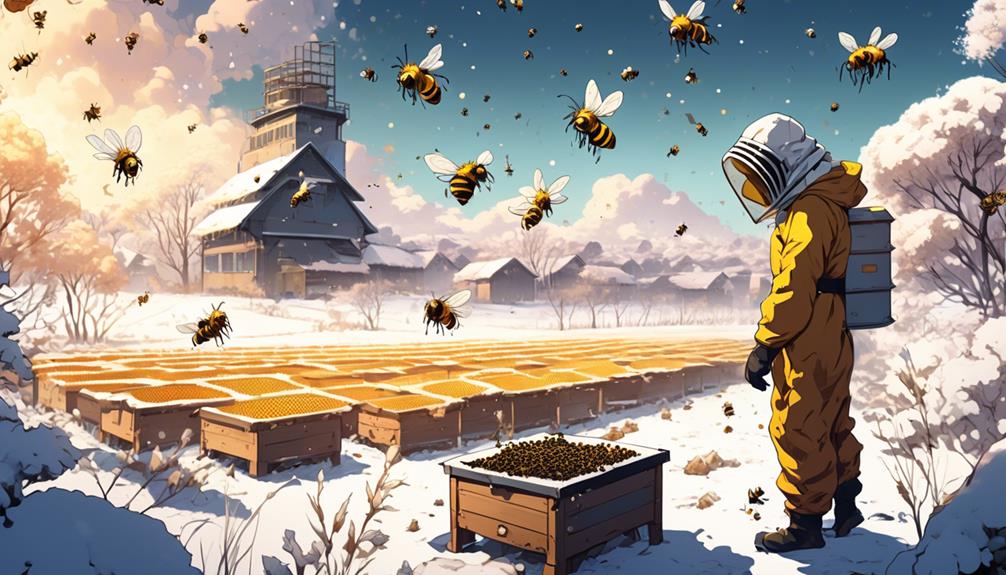
Despite the bees' remarkable resilience and adaptability during winter, human activities can drastically undermine their survival strategies. Urbanization, for instance, leads to habitat loss and fragmentation, reducing the availability of food and nesting sites. Pesticides, particularly neonicotinoids, are also harmful. They can affect a bee's ability to forage, navigate and reproduce, leading to colony collapse.
Climate change, another human-induced factor, impacts the timing of flowering and availability of nectar. This mismatch between bees' biological rhythms and floral resources can have significant consequences on their winter survival. Bees rely on these resources to build up their fat reserves for the winter.
Lastly, the introduction of invasive species and pathogens through global trade can disrupt bee populations. Varroa mites, for instance, are parasites that weaken bees and spread deadly viruses. They're particularly devastating during winter when bees are already under stress.
Frequently Asked Questions
What Are the Main Predators of Bees During the Winter Months?"
In considering bee predators during winter, you might envision bears or birds. However, these aren't the main threats.
In winter, bees face a different kind of predator: the parasitic varroa mite. These mites attach to bees, weakening them and spreading diseases.
Additionally, small hive beetles can invade, eating bee larvae and causing hive destruction.
Do Bees Have Any Unique Hibernation or Migration Patterns Not Found in Other Insects?"
Yes, bees do have unique patterns not seen in other insects. Unlike butterflies or birds, bees don't migrate for winter. Instead, honeybees cluster together in their hives to generate warmth. This is unusual as most insects hibernate or die off in winter.
Additionally, queen bees lay eggs in the fall to ensure hive survival, which is also not common in other insects.
What Is the Average Lifespan of a Bee That Hibernates or Migrates for the Winter?"
You're asking about the average lifespan of a bee that hibernates or migrates for the winter. It's interesting, because bees' lives aren't greatly extended by these behaviors. Typically, a worker bee lives for 5-6 weeks in the summer.
However, those surviving winter can live up to 4-6 months, thanks to a diet richer in proteins. So, hibernation or migration doesn't necessarily increase their lifespan, but it does help them endure the cold months.
Are There Specific Species of Bees That Do Not Hibernate or Migrate?"
Yes, there are specific species of bees that neither hibernate nor migrate.
Tropical bees, for instance, remain active all year round due to the constant warm weather. They don't undergo a period of hibernation or migration.
Additionally, some solitary bees, like mason bees, have life cycles that don't involve hibernation. They lay their eggs and die off, leaving the next generation to emerge when conditions are favorable.
How Does the Change of Seasons Affect the Honey Production of Bees?"
As seasons change, honey production in bees is significantly affected. During warmer months, you'll observe robust honey production as bees can access diverse flora. However, in colder seasons, bees can't forage, reducing honey creation. This pattern might vary depending on the bee species and location.
It's essential to note that factors like temperature, flower availability, and day length play a crucial role in the honey production cycle.
Conclusion
You've seen how bees don't truly hibernate, but rather maintain a winter cluster. Their survival depends on effective migration patterns, collective body heat, and the queen's leadership.
Yet, human activities can disrupt these natural processes. It's crucial we understand and respect these complex behaviors. After all, our survival is tied to these small creatures in ways we're just beginning to comprehend.
So, let's strive to be more bee-conscious in our daily lives.



